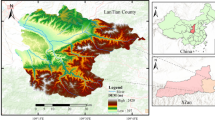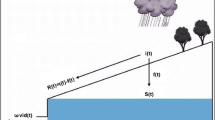Abstract
The spatiotemporal heterogeneity in precipitation and underlying surfaces and hybrid runoff generation mechanism make hydrological modelling and forecasting in semi-arid regions becoming a challenging work. Therefore, to provide a reference for the development of hydrological models in such regions, two nested hydrological experimental watersheds in semi-arid regions were selected for attribution analysis. Based on the concept of large-sample hydrology, large-scale numerical simulation experiments were performed by constructing different spatial and temporal scale rainfall schemes and combining three hydrological models with different runoff generation mechanisms. Finally, the influences of the time step, station density, and model structure on the flood simulations in semi-arid regions were evaluated. The spatial interpolation technique was used simultaneously to describe the high-dimensional complicated nonlinear relationships between the influencing factors and simulation results. The results show the following: (1) the flood simulation accuracy was more sensitive to the time step than the spatial station density of the rainfall schemes and was highly dependent on the time step of the original observation data, and (2) compared with the accuracy of the rainfall schemes, the model structure plays a dominant role in flood simulation accuracy. Thus, the hybrid model has significant potential for flood forecasting in semi-arid regions by combining different runoff generation mechanisms. (3) The spatial interpolation technique based on the k-nearest neighbour algorithm can construct a high-dimensional distribution between the influencing factors and model simulation accuracy, and describe the complicated relationships among the time step, station density, model structure, and flood simulations.
















Similar content being viewed by others
Availability of Data and Material
Not applicable.
Code availability
Not applicable.
References
Al-Qurashi A, McIntyre N, Wheater H, Unkrich C (2008) Application of the Kineros2 rainfall–runoff model to an arid catchment in Oman. J Hydrol 355(1–4):91–105
Altman NS (1992) An introduction to Kernel and Nearest-neighbor nonparametric regression. American Statian 46(3):175–185
Bao WM, Wang CL (1997) Vertical mixed flow model and its application. Hydrology 3:18–21. (in Chinese)
Beck HE, Van Dijk AIJM, Levizzani V, Schellekens J, Miralles DG, Martens B, Roo AD (2017) MSWEP: 3-hourly 0.25 degrees global gridded precipitation (1979–2015) by merging gauge, satellite, and reanalysis data. Hydrol Earth Syst Sci 21(1):589–615
Beven K (1989) Changing ideas in hydrology—the case of physically-based models. J Hydrol 105(1–2):157–172
Berne A, Delrieu G, Creutin JD, Obled C (2004) Temporal and spatial resolution of rainfall measurements required for urban hydrology. J Hydrol 299(3–4):166–179
Blöschl G, Sivapalan M (1995) Scale issues in hydrological modelling: a review. Hydrol Process 9(3–4):251–290
Buda AR, Kleinman PJ, Srinivasan MS, Bryant RB, Feyereisen GW (2009) Factors influencing surface runoff generation from two agricultural hillslopes in central Pennsylvania. Hydrol Process 23(9):1295–1312
Burns DA, McDonnell JJ, Hooper RP, Peters NE, Freer JE, Kendall C, Beven K (2001) Quantifying contributions to storm runoff through end-member mixing analysis and hydrologic measurements at the Panola Mountain Research Watershed (Georgia, USA). Hydrol Process 15(10):1903–1924
Chen RS, Pi LC (2004) Diffusive tank model application in rainfall-runoff analysis of upland fields in Taiwan. Agric Water Manag 70:39–50
Clark MP, Slater AG, Rupp DE, Woods RA, Vrugt JA, Gupta HV, Wagener T, Hay LE (2008) Framework for Understanding Structural Errors (FUSE): A modular framework to diagnose differences between hydrological models. Water Resourc Res 44:W00B02
Duan Q, Sorooshian S, Gupta V (1992) Effective and efficient global optimization for conceptual rainfall-runoff models. Water Resour Res 28(4):1015–1031
Euser T, Winsemius HC, Hrachowitz M, Fenicia F, Uhlenbrook S, Savenjie HHG (2012) A framework to assess the realism of model structures using hydrological signatures. Hydrol Earth Syst Sci Dis 17(5):1893–1912
Green WH, Ampt GA (1911) Studies on soil physics. J Agric Sci 4(1):1–24
Haberlandt U (2007) Geostatistical interpolation of hourly precipitation from rain gauges and radar for a large-scale extreme rainfall event. J Hydrol 332(1–2):144–157
Hassan ST, Lubczynski MW, Niswonger RG, Su Z (2014) Surface-groundwater interactions in hard rocks in Sardon Catchment of western Spain: an integrated modeling approach. J Hydrol 517:390–410
Huang PN, Li ZJ, Chen J, Li QL, Yao C (2016a) Event-based hydrological modeling for detecting dominant hydrological process and suitable model strategy for semi-arid catchments. J Hydrol 542:292–303
Huang PN, Li ZJ, Yao C, Hu CQ, Zhang JZ (2013) Application and comparison of hydrological models for semi-arid and semi-humid regions. J Hydroelect Eng 32(4):4–9. (in Chinese)
Huang PN, Li ZJ, Yao C, Li QL, Yan MC (2016b) Spatial combination modeling framework of saturation-excess and infiltration-excess runoff for semi-humid watersheds. Adv Meteorol 2016: 5173984
Huo WB, Li ZJ, Wang JF, Yao C, Zhang K, Huang YC (2019) Multiple hydrological models comparison and an improved Bayesian model averaging approach for ensemble prediction over semi-humid regions. Stoch Env Res Risk Assess 33(1):217–238
Huo WB, Li ZJ, Zhang K, Wang JF (2020) GA-PIC: An improved Green–Ampt rainfall-runoff model with a physically based infiltration distribution curve for semi-arid basins. J Hydrol 586:124900
Kavetski D, Fenicia F, Clark MP (2011) Impact of temporal data resolution on parameter inference and model identification in conceptual hydrological modeling: Insights from an experimental catchment. Water Resour Res 47:W05501
Kim D, Olivera F, Cho H, Seung OL (2013) Effect of the inter-annual variability of rainfall statistics on stochastically generated rainfall time series: part 2. Impact on watershed response variables. Stoch Env Res Risk Assess 27(7):1611–1619
Krajewski WF, Lakshmi V, Georgakakos KP, Jain SC (1991) A Monte Carlo Study of rainfall sampling effect on a distributed catchment model. Water Resour Res 27(1):119–128
Li BQ, Niu XR, Liang ZM, Zhao WM, Zhang HY (2017) Progress of research on hydrological models for arid and semi-arid areas of the middle Yellow River. Yellow River 39(03):1–4 + 9. (in Chinese)
Li ZJ, Hu WS, Ding J, Hu YZ, Wu YT, Li JW (2013) Study on distributed hydrological model of solving physical equation on grids. J Hydroelect Eng 31(2):5–13. (in Chinese)
Li ZJ, Huang PN, Yao C, Li QL, Zhao LX, Yu ZB (2014) Application of flexible-structure hydrological models in different runoff generation regions. Adv Water Sci 25:28–35. (in Chinese)
Li ZJ, Yao C, Kong XG (2005) The improved Xinanjiang model. J Hydrodyn (Series B) 17(6):746–751
Liang ZM, Jiang XL, Cao YX, Peng SF, Wang K, Wang D (2016) Probabilistic flood forecasting considering rainfall uncertainty. J Hohai Univer (Natural Sciences) 44(1):8–12. (in Chinese)
Lin F, Chen Y, Chen XW, Chen F (2011) Effects of time step length on simulation results of the HEC-HMS. Mount Res 29(1):50–54
Liu X, Xia C, Chen Z, Chai Y, Jia R (2020a) A new framework for rainfall downscaling based on EEMD and an improved fractal interpolation algorithm. Stoch Environ Res Risk Assess 34(1–3):1147–1173
Liu YH, Zhang K, Li ZJ, Liu ZY, Wang JF, Huang PN (2020b) A hybrid runoff generation modelling framework based on spatial combination of three runoff generation schemes for semi-humid and semi-arid watersheds. J Hydrol 590:125440
Mair A, Fares AN (2011) Comparison of rainfall interpolation methods in a mountainous region of a tropical island. J Hydrol Eng 84(4):371–383
Morbidelli R, Corradini C, Saltalippi C, Flammini A, Dari J, Govindaraju RS (2018) Rainfall infiltration modeling: a review. Water 10(12):1873
Nalder IA, Wein RW (1998) Spatial interpolation of climatic normals: test of a new method in the Canadian boreal forest. Agric For Meteorol 92(4):211–225
National Center of Hydrological Information (2008) Standard for Hydrological Information and Hydrological Forecasting GB/T22482-2008, Beijing. China Water Power Press, China
Olsson J, Niemczynowicz J, Berndtsson R (1993) Fractal analysis of high-resolution rainfall time series. J Geophys Res Atmos 98(D12):23265–23274
Ostrowski MW, Wolf U (1984) Effects of temporal discretization on parameter estimation for hydrological models. Deutsche Gewasserkundliche Mitteilungen 28(2):37–40
Piazza AD, Conti FL, Noto LV, Viola F, Loggia L (2011) Comparative analysis of different techniques for spatial interpolation of rainfall data to create a serially complete monthly time series of precipitation for Sicily, Italy. Int J Appl Earth Observ Geoinform 13(3):396–408
Shen YJ, Liu DD, Yin JB, Xiong LH, Liu P (2020) Integrating hybrid runoff generation mechanism into variable infiltration capacity model to facilitate hydrological simulations. Stoch Env Res Risk Assess 34(12):2139–2157
Shen Z, Chen L, Liao Q, Liu R, Hong Q (2012) Impact of spatial rainfall variability on hydrology and nonpoint source pollution modeling. J Hydrol 472–473:205–215
Siuki SK, Saghafian B, Moazami S (2017) Comprehensive evaluation of 3-hourly TRMM and half-hourly GPM-IMERG satellite precipitation products. Int J Remote Sens 38(1–2):558–571
The Yellow River Conservancy Commission Middle Reach Hydrology and Water Resources Bureau (2005) Hydrology in the middle reaches of the Yellow River (from Hekou Town to Longmen). Yellow River Water Conservancy Press, Zhengzhou, pp 18–19. (in Chinese)
Wang SP, Zhang ZQ, Ge S, STEVE M, Zhang ML, Li JL (2008) Effects of grid size and time step of MIKESHE on hydrological processes modeling at watershed scale. Hydrology 28(6):1–7. (in Chinese)
Waymire E (1985) Scaling limits and self-similarity in precipitation fields. Water Resour Res 21(8):1271–1281
Williams JR, LaSeur WV (1976) Water yield model using SCS curve numbers. J Hydrau Div 102(9):1241–1253
WMO (2011) Manual on flood forecasting and warning. World Meteorol Organ, Geneva, MMO-No1072
Xia J, Ye AZ, Qiao YF, Wang GS (2007) An applied research on distributed time-variant gain hydrological model in Wuding river of Yellow River. J Basic Sci Eng 15(04): 457–465. (in Chinese)
Zhang HC, Li ZJ, Ullah S, Li QL (2016) Impact of DEM resolution and spatial scale: analysis of influence factors and parameters on physically based distributed model. Adv Meteorol 2016:8582041
Zhang LJ, Qian YF (2004) A study on the feature of precipitation concentration and its relation to flood-producing in the Yangtze River Valley of China. Chin J Geophys 47(4):622–630. (in Chinese)
Zhao RJ, Zhuang YL, Fang LR, Zhang QS (1980) The Xinanjiang model hydrological forecasting proceedings Oxford Symposium. IASH Press, Wallingford, pp 351–356
Zhao RJ (1983) Brief introduction of rainfall-runoff model. Yellow River 02:40–43. (in Chinese)
Zhao RJ (1992) The Xinanjiang model applied in China. J Hydrol 135(1–4):371–381
Acknowledgements
We thank all reviewers and the editorial board of the issue for their constructive comments on initial draft of the paper.
Funding
This research was supported by the National Key Research and Development Program of China (Grant No.2018YFC1508100), Fundamental Research Funds for the Central Universities, Postgraduate Research & Practice Innovation Program of Jiangsu Province (Grant No. KYCX21_0508), National Natural Science Foundation of China (Grant No. 52079035 and 51679061).
Author information
Authors and Affiliations
Contributions
Yuhuan Liu: conceptualization, formal analysis, investigation, methodology, investigation, visualization, writing draft, writing-review & editing. Zhijia Li: conceptualization, methodology, writing-review & editing, funding acquisition. Zhiyu Liu: writing-review & editing. Yun Luo: visualization, writing-review & editing.
Corresponding authors
Ethics declarations
Conflicts of Interest
The authors declare no conflict of interest.
Additional information
Publisher’s Note
Springer Nature remains neutral with regard to jurisdictional claims in published maps and institutional affiliations.
Rights and permissions
About this article
Cite this article
Liu, Y., Li, Z., Liu, Z. et al. Impact of rainfall spatiotemporal variability and model structures on flood simulation in semi-arid regions. Stoch Environ Res Risk Assess 36, 785–809 (2022). https://doi.org/10.1007/s00477-021-02050-9
Received:
Accepted:
Published:
Issue Date:
DOI: https://doi.org/10.1007/s00477-021-02050-9




